SideFX ships Houdini 18
Originally posted on 4 November. Scroll down for news of the commercial release.
SideFX has unveiled the new features in Houdini 18, the next major update to its procedural 3D animation and effects software, at its product launch event yesterday.
The release will introduce new artist-focused modelling tools, add a new Substance integration plugin, and overhaul Houdini’s key simulation toolsets, including the Vellum, FEM, Pyro and FLIP fluid solvers.
Solaris, SideFX’s much-anticipated look dev and shot layout system, will also ship as part of Houdini 18.
Solaris: a complete new USD-based look dev and layout toolset
The biggest new feature in Houdini 18 – and one to which half of the presentation at the launch event was devoted – is Solaris: a new USD-based lighting, look development and shot layout environment.
The toolset is designed to enable less technically minded artists to use Houdini as a look dev and layout tool, using a non-destructive drag-and-drop workflow.
We covered Solaris when SideFX unveiled it at Siggraph, so check out our original story for an overview.
However, what comes across clearly in the launch presentation is how artist-friendly the tools are.
At 00:21:30 in the video above, you can see the lighting toolset, which supports a workflow reminiscent of tools like HDR Light Studio, but greatly extended.
As well as clicking on the surface of a model to align lights or position specular highlights, artists can click on surrounding surfaces to position the shadows they cast: a workflow described as “like painting with light”.
Users can also draw a focal plane in a scene to define depth of field.
New Karma renderer set to become a replacement for Mantra in production
Another interesting announcement from the launch event is that Karma, the new render engine developed for Solaris, is set to become a full replacement for Houdini’s Mantra renderer.
“We couldn’t continue with Mantra,” said SideFX VP of product development Cristin Barghiel. “It belonged in another environment, not one that is USD-native.”
In the chat channel for the livestream, SideFX confirmed that Mantra will only receive bugfixes from now on.
Although Karma was initially intended as a tool for visualising dense production scenes during look dev and layout, SideFX emphasised that it is “a full production renderer … not just a preview renderer”.
Another interesting feature shown in the presentation is the set of Hydra render delegates, which enable users to choose which render engine Solaris will use to display assets in the 3D viewport.
As well as Solaris’s native Karma renderer, and the previously announced support for RenderMan, there are delegates for both Arnold and, less predictably, AMD’s Radeon ProRender.
Support for V-Ray, Redshift and 3Delight is also planned.
New artist-focused modelling tools, plus updates to key SOPs for procedural modelling
Although the entire first half of the launch event was devoted to Solaris, there are also a lot of other new features in Houdini 18, covered from 00:57:30 in the video.
You can also see a high-speed run-down in SideFX’s teaser video, embedded immediately above.
The modelling tools get one of the longest changelogs, with the update continuing the trend established in recent releases of exposing Houdini’s existing functionality in more artist-friendly ways.
Examples include new options to slide points, edges and faces around manually when using the interactive modelling tools; and a new interactive Point Weld tool for merging vertices in geometry.
For procedural modelling, there are updates to several of Houdini’s key SOP (Surface OPerator) nodes.
The Bend SOP has been overhauled to make workflow more accessible, including more intuitive control handles and hotkeys for operations like snapping.
Senior product designer Scott Keating described the work as an attempt to make the tool “feel more like what you’d expect it to feel like”.
The Bevel SOP – previously PolyBevel – gets support for convex bevels, plus better collision recognition.
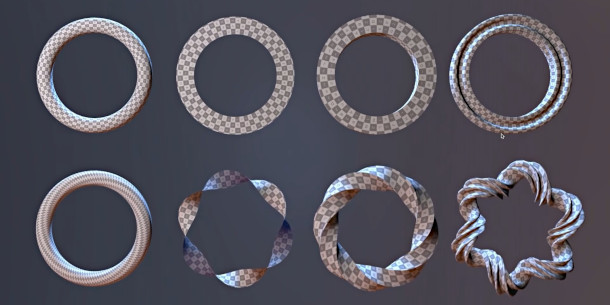
There is also a “powerful suite of redesigned Sweep and Sweep-derived SOPs”: not orignally shown in the teaser video, but covered at 01:03:00 in the launch presentation.
Houdini computes UVs for swept geometry automatically, avoiding seams along U or V boundaries, with the UVs updating when the geometry is animated.
For artists using Houdini to generate terrain, the HeightField Terrace SOP has also been updated, including the option to use a custom profile graph to control the sizes of the steps it generates.
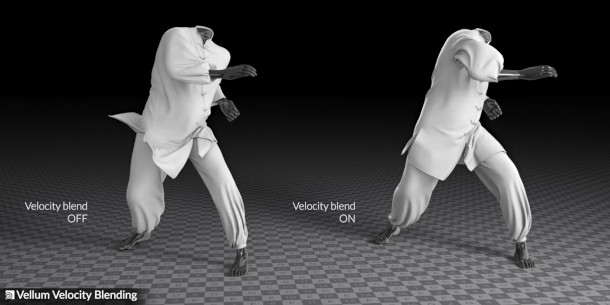
More accurate Vellum simulations for soft bodies and cloth
Houdini’s principal simulation toolsets have also been updated, improving the realism of complex simulations, and reducing simulation times.
Vellum, the cloth/multiphysics solver introduced in Houdini 17, gets support for velocity blending.
Users can control how velocity is transferred to the simulation, making it possible to tone down physically accurate, but visually distracting, secondary motion of cloth.
There is also a new sliding constraint for the solver, which enables the point of constraint to move freely across the surface of geometry: for example, enabling the constrained object to move under gravity.
You can see the workflow at 01:19:00 in the recording of the launch event.
SideFX also says that the resolution-independence of simulations has been improved, so low-resolution test sims should be more representative of the final high-res output.
In addition, the Vellum solver is now 64-bit.
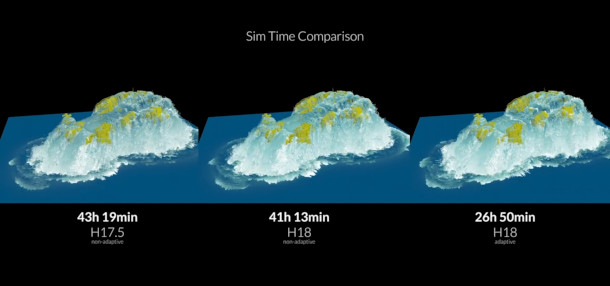
Faster fluid simulations – both for FLIP liquids and Pyro smoke and fire
Changes to fluid simulation include support for adaptive pressure projection when using FLIP fluids.
The system adjusts the size of simulation grid cells automatically, focusing computational effort on key areas, such as the liquid surface and areas of contact with rigid bodies.
In the test scenes shown, activating adaptive projection cuts simulation times by 30-40%: in the case of a fairly complex shot of a submerged craft surfacing, from 41 hours 13 minutes to 26 hours 50 minutes.
The Pyro solver, used for simulating gaseous fluids, also gets a big update.
SideFX described Houdini 18’s ‘sparse’ Pyro solver, which focuses computation on active parts of the fluid container, as “basically … completely new”, although parts of the old code base have been reused.
In the demo scenes shown, the new solver cuts both simulation times and file sizes to around a third compared to the previous implementation – although interestingly, voxel count actually rises.
In addition, the entire Pyro pipeline, including post-processing, is now available in SOPs.
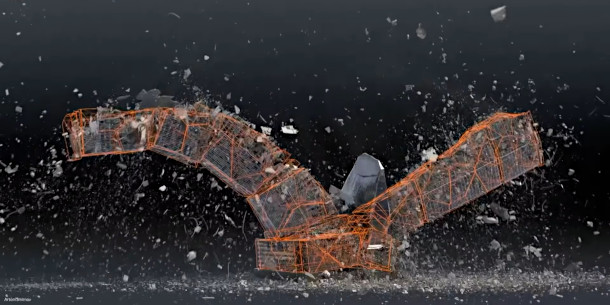
New art-directable fracturing tools for destruction sims
Houdini 18 also introduces a number of improvements to the destruction toolsets.
When fracturing geometry, the chipping algorithm has been improved, generating chips more selectively in the places where they should occur, such as the sharp ends of larger fragments.
There are also new options to control which fracture lines are shown when visualising fractured geometry.
The entire fracturing process is now more art-directable, including the option to use custom cutter objects to break up the base geometry.
Destruction sims can also now be driven by the Bend SOP or FEM solver, resulting in some pretty crazy effects, such as the skyscraper being cleaved by a giant axe shown above.
Again, the “entire destruction pipeline” is now available in SOPs.
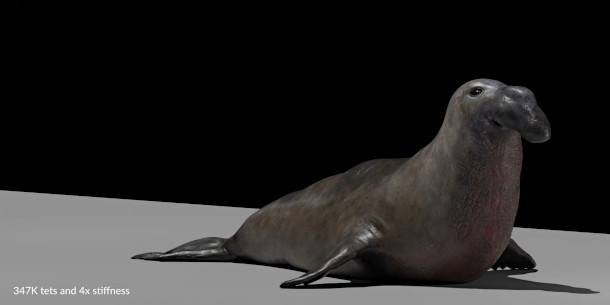
New Neo-Hookean material model preserves volume better in the FEM solver
The FEM solver itself, often used for simulating organic tissue, gets a new Neo-Hookean material model, which should preserve volume better than the previous Corotational model.
Another interesting aspect of the solver shown in the launch event was the option to set the properties of the surface independently of the main volume of the simulation.
At 01:23:40 in the recording of the event, you can see the FEM solver in use to simulate the flesh of an elephant seal, including the effect that the stiffness parameter has on the wrinkling of the character’s skin.
Support for blendshapes in crowd simulations, plus improved export to other DCC software
And although they aren’t shown in either demo, the feature list reveals that Houdini 18 will also feature improvements to the crowd simulation tools.
The update adds support for blendshape animation in crowd agents, which should make it easier to give crowd characters unique facial expressions.
For pipeline integration, Houdini now supports USDSkel when exporting characters in USD format; and there are improvements when round-tripping crowd animations with other DCC tools in FBX format.
Other changes: workflow improvements, new Substance plugin and Python 3 support
Other highlights from the Houdini 18 feature list include a “redesigned, stroke-based” Attribute Paint SOP for 3D painting objects in the viewport, although again, it isn’t shown in either video.
Workflow improvements include the option to use hotkeys for radial menu controls, and to perform 2D pans and zooms when navigating the 3D viewport.
In addition, the update introduces “initial support” for Python 3, ahead of its introduction in next year’s industry-wide VFX Reference Platform specification.
Outside the core software, there is a new Substance integration plugin, for editing procedural materials in .sbsar format. You can find full details in our original story.
The launch event also showed plugins for other third-party tools – some new, some already released – including RealityCapture, ZBrush bridge GoZ, retopology tool QuadRemesher, and UV app RizomUV.
Other useful-sounding add-ons include an Extract Silhouette SOP, a MTL file format importer for OBJ models, and a Quadrangulate SOP for converting triangular meshes to all-quad geometry.
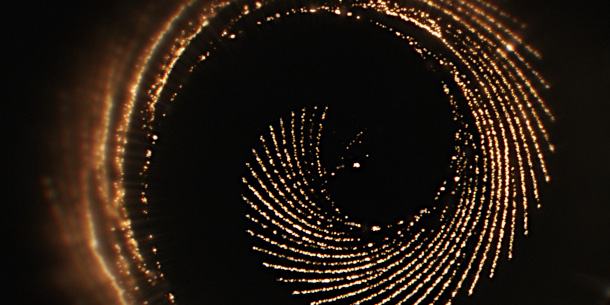
Updated 27 November 2019: Houdini 18 is now shipping. You can see SideFX’s overview of the features, including video demos of the key tools, on its website.
Pricing and system requirements
Houdini 18.0 is available for Windows 8+, Mac OS X 10.12+, and Linux distros.
Houdini FX costs $4,495 for a node-locked licence; $6,995 for a floating licence. Houdini Core, which lacks simulation tools, costs $1,995 for a node-locked licence; $2,995 for a floating licence.
There is also a free Houdini Apprentice learning edition and a lower-cost, rental-only Houdini Indie edition. Both save in their own file formats and have feature restrictions. See a product comparison table here.
